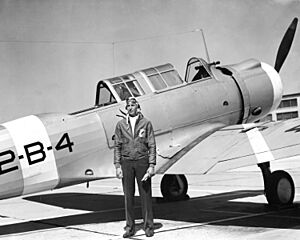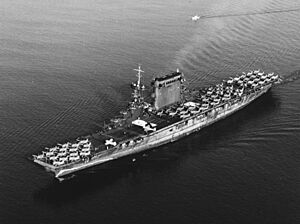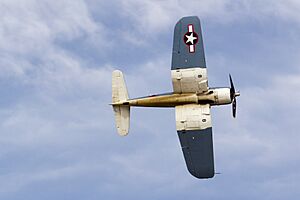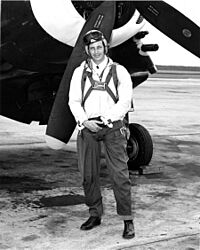Boone Guyton facts for kids
Quick facts for kids
Boone Tarleton Guyton
|
|
|---|---|
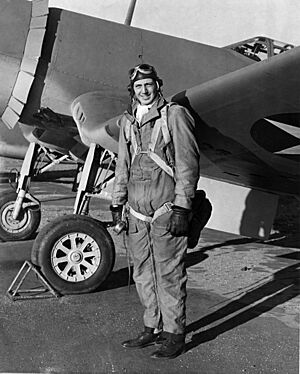
Boone T. Guyton
|
|
| Born | September 4, 1913 East St. Louis, Illinois |
| Died | April 4, 1996 (aged 82) Woodbridge, Connecticut |
| Allegiance | United States of America |
| Service/ |
United States Navy |
| Years of service | 1935-1939 |
| Rank | LTJG |
Boone Tarleton Guyton (September 4, 1913 – April 4, 1996) was an amazing Navy pilot, a brave test pilot who flew experimental planes, an author, and a smart businessman. His flying career stretched from the time of old biplanes to the fast jet age. Guyton is best known for his time as a test pilot at Vought-Sikorsky (Chance Vought). He helped develop the famous F4U Corsair and other military aircraft like the OS2U Kingfisher and the super-weird Vought V-173 "flying pancake."
Contents
Boone's Early Life
Boone Guyton was born in East St. Louis, Illinois, on September 4, 1913. His father passed away when Boone was young, so his mother, Martha, raised him and his older brother during the tough times of the Great Depression in the United States.
Boone graduated from East St. Louis High School in 1931. He then went to Central Methodist College in Missouri, graduating in 1935. He was a star football player! In 1934, his team won the championship, and Boone was the top scorer in the league. He even set a college record for catching seven touchdowns in the end zone. He was so good that he was mentioned in Ripley's Believe It or Not for scoring all his touchdowns without actually carrying the ball across the goal line!
Becoming a Pilot
When Boone was 14, in 1927, he became fascinated with flying after watching Charles Lindbergh fly his plane, the Spirit of St. Louis. Lindbergh was Boone's hero! Even though Boone loved flying, he thought it would be too expensive to become a pilot.
After college in 1935, jobs were hard to find because of the Great Depression. Boone got a teaching job offer, but he didn't feel like teaching was for him.
Soon after, he received an exciting letter from the U.S. Navy. It announced a new program for aviation cadets at Naval Air Station Pensacola in Florida. Boone applied and was accepted! In 1936, he graduated as one of the top students in the very first class, even though almost half the students didn't make it through the tough training.
For the next three years, Boone flew for the Navy. He flew from Naval Air Station North Island in San Diego, California, and from aircraft carriers like the USS Lexington and USS Saratoga. He flew in many places around the world, including Midway, Honolulu, and Panama. Boone was part of Bombing Squadron Five, flying mostly Boeing F4B-4 planes. In 1937, his squadron on the USS Lexington helped search for the famous pilot Amelia Earhart, but Boone was on leave at the time.
Becoming a Test Pilot
As his three years as a Navy pilot were ending, Boone planned to become a co-pilot for TWA, a major airline. But just days before leaving the Navy, he met someone from Vought-Sikorsky, an aircraft company. He got an amazing job offer: to be a test pilot for Vought! His job would be to teach the French Navy how to fly American dive-bombers. His last day as a Navy pilot was July 16, 1939.
Boone spent the next three days at Vought's factory in Connecticut, learning everything he could about the SB2U Vindicator plane (which the French called the V-156). He was getting ready to leave for France.
During those busy three days, Boone also saw a model of Vought's new, super-fast, single-seat fighter plane, the XF4U-1. This plane would later become known as the legendary F4U Corsair. He left for Paris in August 1939, just a month before World War II began with the Nazi Blitzkrieg against Poland.
In France, as War Looms
Boone stayed in France for six months. He first lived in Paris and flew from Orly Airport. Later, he moved to Brest because Paris was having frequent nighttime curfews, air-raid sirens, and trips to bomb shelters. Boone spent most of his time testing the new V-156 aircraft as they arrived from the U.S. and training French pilots. The French believed these planes would be used to attack Nazi tanks.
While at Orly Field, Boone almost became only the second American pilot to fly the famous Messerschmitt Bf 109 fighter plane before World War II. The only other American known to have flown it was Charles Lindbergh in 1938. A Messerschmitt pilot had landed in France with engine trouble, and the plane was brought to a French airfield. Boone had arranged to test it after a French racing pilot named Michel Detroyat. Sadly, Detroyat had mechanical problems with the plane's brakes, and it was damaged when he landed, so Boone missed his chance.
By January 1940, tensions in Europe were very high, and the Nazis were threatening France. Because of neutrality laws, Vought ended Boone's assignment and sent him back to the United States. He left France through Italy, where he boarded an American ocean liner, the SS Manhattan. This ship was supposed to be safe from German U-boat attacks. Boone arrived in New York on January 24, 1940.
The Vought Years: Testing Famous Planes
When Boone returned to the U.S., he needed a job again. Things were quiet at Vought because the new XF4U-1 Corsair prototype wasn't ready to fly yet, and the OS2U Kingfisher hadn't started production. With no other choices, Boone accepted a job offer from TWA and finally flew for the airline he had almost joined three years earlier. His airline career began on March 6, mostly flying DC-3s.
But just three months later, Boone got another job offer from Vought's Rex Beisel to be an experimental test pilot. At the end of May 1940, Boone left TWA and started working for Vought's chief of flight test, Lyman Bullard. This was just before the Corsair's very first flight on May 29.
On July 9, Boone flew the XF4U-1 for the first time. During his fifth flight in the plane, on July 11, Boone got caught in bad weather during high-speed testing. He ran out of fuel and had to make an emergency landing on a golf course. The Corsair slid into some trees and flipped over. Luckily, the damage could be fixed, and it only delayed the program by two months. Later, on October 1, the XF4U-1 became the first single-seat production fighter to fly faster than 400 miles per hour (it actually reached 405 mph!).
Boone continued testing the XF4U-1 Corsair, as well as different versions of the SB2U Vindicator and OS2U Kingfisher. On June 25, 1942, he flew the very first production F4U-1 Corsair to come off the assembly line. From then on, the Corsair testing became incredibly busy, and Boone spent most of his time with that plane. The next few years also included frequent trips to Navy bases across the country to train Navy pilots on the fighter that would soon take them into combat. One of his "students" was Captain Tom Blackburn of the VF-17 squadron, also known as the VFA-103 "Jolly Rogers."
Besides his work on the Corsair, Boone was also named the chief experimental test pilot for the Vought V-173 "flying flapjack" (or flying pancake) prototype. He took the V-173 on its first flight on November 23, 1942. This plane was meant to be the next great propeller-driven fighter design. However, development of the XF5U (the high-speed fighter version of the V-173) was stopped in 1947 before it ever flew. The Navy had decided to focus on jet-propelled aircraft instead.
In late October 1944, Boone took part in a Navy Fighter Meet where pilots from the military and different manufacturers tested and compared military aircraft. There, he finally got to fly a captured Japanese A6M Zero fighter and the amazing, jet-powered Bell YP–59A Airacomet.
By 1945, Boone had spent more than 650 hours testing Corsairs (many different versions!) and almost 33 hours in the V-173.
In 1948, Vought moved its factory from Connecticut to Dallas, Texas. Boone continued to fly later versions of the Corsair (F4U-7 and AU-1) as well as Vought's new jets: the F6U Pirate and the F7U Cutlass. He decided to leave Vought in 1951 after 12 years, ending his career as an experimental test pilot. His last flight for Vought was on April 17, 1951. He volunteered to deliver a F6U Pirate from Texas to New Mexico, where it would join other old, unused aircraft. During the flight, a hydraulic system failed, forcing Boone to make an emergency landing. He walked away unharmed!
Boone's Connection with Charles Lindbergh
In early 1943, Charles Lindbergh began helping Vought with the engineering of the F4U Corsair. Both Lyman Bullard and Boone Guyton explained the F4U-1 to the legendary pilot before Lindbergh's first Corsair flight on January 6, 1943. Lindbergh flew the plane three more times that day, then left Vought and returned a month later.
One evening, Lindbergh and Guyton shared thoughts over dinner. They talked about flying and other things, including their friend, the French pilot Michel Detroyat. Lindbergh mentioned that it was Detroyat who helped him escape from the huge crowds of excited fans the night he landed the Spirit of St. Louis in Paris.
In March 1943, Boone had a very serious crash landing. The engine in his F4U stopped working at 22,000 feet, and he tried to glide it back to the factory's airport. The plane literally broke in half when it hit the ground. One of his first visitors at the hospital, besides his wife, was Lindbergh himself.
Boone's friendship with Lindbergh continued throughout the war, including a dinner at Lindbergh's new home in Connecticut in late 1944.
After Vought
After leaving Vought, Boone returned to New England with his wife and four children. They settled in Woodbridge, Connecticut, where they had a fifth child. Boone took on various management jobs at companies like Hamilton Standard and United Technologies Corporation, and eventually started his own company.
Boone continued to fly for fun until 1982, when he stopped for good. That was forty-seven years after he joined the Naval Aviation Cadet program! He flew over 100 different aircraft, including almost all the top fighters of World War II like the P-51 Mustang, Supermarine Spitfire, P-47 Thunderbolt, P-38 Lightning, F4F Wildcat, Japanese Zero, F6F Hellcat, and Curtiss P-40. But he is best remembered as the chief experimental test pilot for the amazing Corsair.
During his retirement, Boone Guyton gave talks about the Corsair and the V-173. He also continued to write. His third and last book, Whistling Death – the Test Pilot's Story of the F4U Corsair, was published in 1990.
Death
Boone Guyton passed away from cancer on April 4, 1996, at the age of 82. He is buried in Woodbridge, Connecticut, where he lived for the last 40 years of his life. He is survived by his five children, eight grandchildren, and five great-grandchildren.
Images for kids


